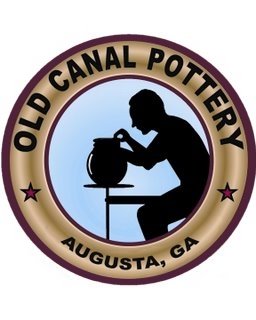
I've spent the past week turning pots and other assorted chores with hopes of firing another load of pots in a week or two. Pretty ambitious! The museum at the Augusta Canal Authority will be getting many of the pots from the last firing to re-sell so I must replenish my stock. With a wood-fired kiln, the wood cutting/gathering/stacking is an ongoing chore. It never stops! Pictured below is a pallet factory waste pile. It is full of mostly thin hardwood that burns hot and fast.
 I use 100% scrap wood from various sources to fire the kiln. Resinous pine scrap is prefered. No matter what species, it must be dry. Wood is spot checked with a moisture meter.
I use 100% scrap wood from various sources to fire the kiln. Resinous pine scrap is prefered. No matter what species, it must be dry. Wood is spot checked with a moisture meter.This next photo is of some Oxacan-style pots I made. I burnished them with a spoon to give them a shine, scratched designs on the surface, then fired them in a brush pile in a can of sawdust to heavily reduce or blacken them. It's fun to play!

Below is a piece I like alot that is now in a private collection. I call it the Lawyer. He's objecting politely.

I'm the originator of the dog jug or in Georgia, "dawg" jug. These have a lot of character! They're time-consuming to make but a favorite of mine and popular in collections.

Here's one of my chickens. They tend to vary a lot but are quite different from other folk potters. They have quite a bit of detail, including feathers.
 This next piece goes beyond unusual! It is based on the old slave face jugs made at some of the Old Edgefield District potteries that were located around here in the 1800's. Yes, yes, I know, he's creepy! This form is actually a wigstand or wig holder and has a bonifide purpose. Unfortunately, a full head of hair doesn't help the poor thing a bit!
This next piece goes beyond unusual! It is based on the old slave face jugs made at some of the Old Edgefield District potteries that were located around here in the 1800's. Yes, yes, I know, he's creepy! This form is actually a wigstand or wig holder and has a bonifide purpose. Unfortunately, a full head of hair doesn't help the poor thing a bit!
I thought I'd share a few unusual forms I make periodically with you and will post more as time permits.

 I'm stoking and carefully standing behind the door. The heat is incredible anytime the door is open and will render your legs hairless and as smooth as a baby's bottom!
I'm stoking and carefully standing behind the door. The heat is incredible anytime the door is open and will render your legs hairless and as smooth as a baby's bottom! Some rolling fire working magic on pots.
Some rolling fire working magic on pots.





 On the way to kiln. I love these little carts! I think I'll spiff it up with some dividers and sides as well as some period colors on the cast iron fittings and wheels.
On the way to kiln. I love these little carts! I think I'll spiff it up with some dividers and sides as well as some period colors on the cast iron fittings and wheels.
 Heavy smoke from blasting off kiln. Actually, the smoke is just starting. It forms huge clouds of thick, black, tar-like smoke for a miute or two followed by an orange flame that shoots up and out of chimney. These blasting cycles go on for an hour and a half, typically.
Heavy smoke from blasting off kiln. Actually, the smoke is just starting. It forms huge clouds of thick, black, tar-like smoke for a miute or two followed by an orange flame that shoots up and out of chimney. These blasting cycles go on for an hour and a half, typically. Setting the kiln. This takes two persons. Usually, someone is on the outside placing pots on a long plank that is slid in to me on the inside to set. The buttocks and hamstrings get incredibly sore for a day or two after crawling around.
Setting the kiln. This takes two persons. Usually, someone is on the outside placing pots on a long plank that is slid in to me on the inside to set. The buttocks and hamstrings get incredibly sore for a day or two after crawling around.
 Late night shot of the business end of kiln at full heat. This scene gets real mesmerizing after 7 or 8 hours of staring at the bright light in the darkness of night. You stumble like a crazed zombie looking for the next chunk of wood to throw in.
Late night shot of the business end of kiln at full heat. This scene gets real mesmerizing after 7 or 8 hours of staring at the bright light in the darkness of night. You stumble like a crazed zombie looking for the next chunk of wood to throw in. Stan hauls some pots to kiln. Thanks! Notice the railroad tracks that run by the studio to the kiln. This is where some of the world's finest cotton cloth was shipped out from Enterprise Mill in its former life.
Stan hauls some pots to kiln. Thanks! Notice the railroad tracks that run by the studio to the kiln. This is where some of the world's finest cotton cloth was shipped out from Enterprise Mill in its former life. Here is a view of the pots after firing
Here is a view of the pots after firing
 Some of the fired pots back in the studio.
Some of the fired pots back in the studio.